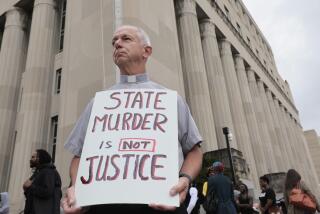Less Fodder for Death Row
- Share via
The U.S. Supreme Court’s decision Tuesday to bar the execution of juvenile murderers has come at a pivotal time in this nation’s long and agonized debate over the death penalty.
Unlike in the cases of the 100-plus death row defendants released in recent years when DNA or other evidence proved them innocent, Christopher Simmons’ guilt was not in doubt. Simmons was 17 and a Missouri high school junior when he and a friend entered Shirley Crook’s house, bound the 46-year-old woman with duct tape, drove her to a state park and threw her from a bridge to drown in the water below. Before the crime, Simmons bragged to friends that they would “get away with it” because they were minors. Soon after his arrest, he not only confessed to Crook’s murder but agreed to perform a videotaped reenactment for police. A jury sentenced him to death.
The question before the high court was the fairness and propriety of Simmons’ sentence. Capital punishment is reserved for society’s worst offenders, wrote Justice Anthony Kennedy for a sharply divided court. But because teens are still emotionally immature, they cannot be held responsible in the same degree as adults for their actions, however unforgivable. For that reason, their execution violates the Constitution’s ban on cruel and unusual punishment.
“The age of 18 is the point where society draws the line for many purposes between childhood and adulthood,” Kennedy wrote. “It is, we conclude, the age at which the line for death eligibility ought to rest.”
Tuesday’s ruling throws out the sentences of 72 murderers in 12 of the 20 states that permit capital prosecutions of defendants who were under 18 at the time of their crimes. California law reserves the death penalty for offenders 18 and over.
Opinion polls show Americans softening in their support for the death penalty. Learning that so many innocent defendants spent years on death row before being exonerated has shaken many death penalty proponents.
The high court’s new ruling comes three years after it outlawed the death penalty for the mentally retarded. Both decisions were pointedly grounded in what the court describes as a changing national consensus on capital punishment. But, as with the headline-making exonerations, those decisions magnify as well as reflect the public’s doubts. Add in many other obvious inequities -- name a rich person awaiting execution, for one -- and death row is increasingly revealed for what it is: a dumping ground for the poorest defendants with the lousiest lawyers rather than the most despicable killers.
More to Read
Sign up for Essential California
The most important California stories and recommendations in your inbox every morning.
You may occasionally receive promotional content from the Los Angeles Times.










